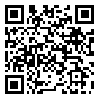Volume 17, Issue 10 (January 2020)
Nursing and Midwifery Journal 2020, 17(10): 818-825 |
Back to browse issues page
Download citation:
BibTeX | RIS | EndNote | Medlars | ProCite | Reference Manager | RefWorks
Send citation to:



BibTeX | RIS | EndNote | Medlars | ProCite | Reference Manager | RefWorks
Send citation to:
Aghakhani N, Baghaei R, Alnezhad V, Solaimani4 O. THE EFFECT OF NON-ATTENDANCE EDUCATION ON THE INTENSIVE CARE UNITS NURSES’ PRACTICE ABOUT NASOGASTRIC TUBE INSERTION STANDARDS IN UNIVERSITY HOSPITALS, URMIA, 2016. Nursing and Midwifery Journal 2020; 17 (10) :818-825
URL: http://unmf.umsu.ac.ir/article-1-2939-en.html
URL: http://unmf.umsu.ac.ir/article-1-2939-en.html
1- Assistant Professor, Patient Safety Research Center, Urmia University of Medical Sciences, Urmia, Iran
2- Associate Professor, Faculty of Nursing and Midwifery, Urmia University of Medical Sciences, Urmia, Iran
3- Assistant Professor, Faculty of Nursing and Midwifery, Urmia University of Medical Sciences, Urmia, Iran
4- Master of Internal Surgery, Faculty of Nursing and Midwifery, Urmia University of Medical Sciences, Urmia, Iran (Corresponding Author) ,rebaz.nursin@gmail.com
2- Associate Professor, Faculty of Nursing and Midwifery, Urmia University of Medical Sciences, Urmia, Iran
3- Assistant Professor, Faculty of Nursing and Midwifery, Urmia University of Medical Sciences, Urmia, Iran
4- Master of Internal Surgery, Faculty of Nursing and Midwifery, Urmia University of Medical Sciences, Urmia, Iran (Corresponding Author) ,
Abstract: (3935 Views)
Background & Aims: Nasogastric tube insertion is one of the most important therapeutic functions usually performed by nurses in the intensive care units and proper placement of it requires the skill and proper performance of nurses to meet the established standards and reduce potential complications. Obviously, this requires training of nurses. However, non-attendance education can be a good way to improve nurses' performance. Accordingly, this study aimed to investigate the effect of non-attendance education on the performance of Bachelor and higher degree nurses in adhering to nasogastric tube insertion standards in university hospitals in Urmia. Materials & methods: In this semi-experimental study about 60 nurses working in intensive care units in Urmia were included. Samples were randomized and divided into case and control groups. The case group was taught by an educational pamphlet and a CD. Data were gathered by a 25 question checklist about NGT insertion based on valid standards practice with an observational method by researchers. The performance of the subjects was evaluated by two stages: pre-test in both groups and post-test in the case group. Data were analyzed using descriptive and analytic statistics by SPSS version 22. Results: The mean age of participants in case group was 31.05 and it was 30.89 in the control group. The mean years of service was 7.68 and 7.77 in the control and case group, respectively. It was also found that the practice of nurses working in intensive care unit is far from the standards in the field of nasogastric tube insertion. The mean performance score (out of 100) in the control and case groups before the intervention was 71.58 and 70.48, respectively, and the mean score of the case group after the intervention was 86.80 which increased by 16.32 and was statistically significant (p = 0/0001). Conclusion: Promoting nonattendance education in a variety of ways in the clinical setting for nurses can improve performance levels in therapeutic procedures, including adherence to standards of nasogastric tube insertion in specialized units, and ultimately improve the quality of treatment and reduce the adverse effects of mistakes in a positive way. Similar training methods are recommended.
Send email to the article author
| Rights and permissions | |
 |
This work is licensed under a Creative Commons Attribution-NonCommercial 4.0 International License. |





 gmail.com, unmf
gmail.com, unmf